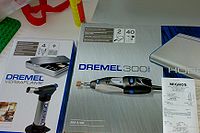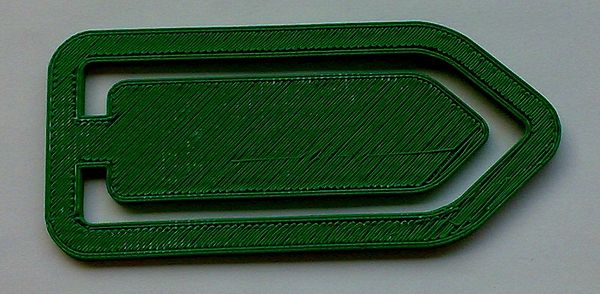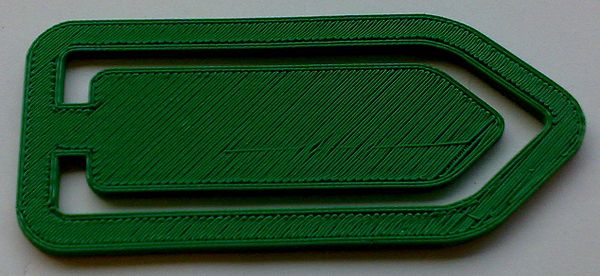Post processing of 3D polymer prints
Introduction
This articles describes how to clean up and otherwise post-process 3D prints made with a 3D printer like the RapMan that prints polymers like ABS or PLA.
Getting the print off the raft
RepRap printers like the RapMan require the use of a raft for polymers like ABS. To get it off from the print bed, use a flat kitchen knife. Use a sawing movement if it sticks too much.
Alternatively, you can try various solvents, e.g. to remove Ninja Flex and similar, I use alcohol.
To remove the object from the raft: First, try to pull it off gently, then use the same knife and scrap like you would peel a carrot.
When this doesn't work, cut of or file off the remaining strands from the interface layer.
Removing small imperfections
Prints always have imperfections, e.g. small parts that stick out and that you will have to remove. You can do this mechanically or by using fire, heat or a solvent.
Knifes, pliers, scissors and abrasive files
Remove larger stringings and other stuff that sticks out with a small and sharp knife or little scissors. A little Swiss Army "key ring" knife that you can buy for about 10 Euros will do nicely. Alternatively or in addition, you can use a stanley cutter, small and sharp pliers, scalpels (can be found on the flea market), wood cutting tools or high-end kitchen knifes.
Alternatively or in addition you may buy a cutting mat and cutting knives. The former is to avoid cutting into your table and the latter can be used instead of the small army knife. I bought a kit for about 6 Euros.
Then, to remove other imperfections like bulges, use the files that you bought for assembling the printer.
As alternative or in addition, get yourself a cheap hobbyist rotation-tool with a set of accessories. A Dremel "multi tool" for carving, grinding, cleaning, sanding, etc. costs about 50 Euros or less at discount princes. Typical accessories are:
- Carving tools (to carve holes that you can't print)
- Grinding/sanding tools, to remove imperfections or irregular bottom layers. Although for the latter, I'd rather use a file.
- Cleaning/polishing tools, to remove small imperfections (see also the use of fire or acetone)
After some processing, the object will have ugly spots (plastic is whitish instead of colorful), and you will have to bring the color back, read on ....
Using fire
Fire may be used for several purposes: Bringing back color to spots where you cut or used an abrasive file, remove tiny strinings, and bending. You also can soldier PLA with fire. However, be careful: ABS loves to burn and PLA melts down pretty fast !
I found that holding an object over the kitchen gas will bring back color. Do not use a candle. Take a glove or hold it with a plier and move it quickly back and forth fairly close to the flame. Now be careful: ABS will start bending and becoming soft very fast, i.e. it will bend towards the heat source and alter its form. To prevent this for 2D objects like a paper clip, flip the object over (180 degrees to the other side).
Using a small torch
Using your kitchen stove is not really practical since the flames are too wide, i.e. when heating up a part you likely will burn another. So I got myself a little mini-torch for about 50 Euros, i.e. a Dremel gas torch (amazon uk link). It's small and easy to fill from a cigarette lighter gaz container.
Disclaimer: Tested with ABS and PLA, don't blame me if you burn your office down.
Procedure: Quickly pass over all the "white" areas, don't go to close or the plastic will inflame. Flip over 2D objects. I did not try to meld plastic or to smooth out a whole surface. Purpose was to (a) burn the "white away" and (b) other little things that stick out. With PLA this torch seems to even more useful. Torching an object doesn't make it stink (PLA is made out of corn starch) and it's therefore fairly easy to burn of things that stick out or to make a flat bottom. However, be careful: PLA starts melting pretty soon...
Open the windows or do it outside. I don't think that fumes are so healthy.
Note: You see here the bottom of the object (you can see the front side here. There are other imperfections, but they are rather due to bad calibration (should have made somewhat fatter lines which I did in other paperclips)
Warnings:
- ABS can burn easily and fumes are not healthy.
- PLA will melt down fast and you can damage your object. It does not behave like ABS, i.e. ABS slowly becomes more malleable, whereas PLA will melt down all of a sudden. Therefore, only use fire to melt away the many typical tiny strings or if you really plan to melt, e.g do some soldering.
Hot air
Hot air guns can be used to:
- Remove small filaments from PLA and ABS. However, you probably need a model with small exit adapter.
- Bring back color after sanding/filing
- Heat both PLA and ABS in order to change the shape (bending).
- Make pieces fit that are too tight. E.g. I print rather print Lego-compatible blocks a bit too tight and then heat before I press them down into a real Lego block
Hot air guns work like a hair dryer, but:
- Heat from 50 to 650 degrees (Celsius)
- Have adjustable air flow (volume)
- Provide several types of nozzles
In the picture to the right is a 50 Euro (Amazon.de) / 80 CHF (Migros) unit that can do, i.e. we bought one. Better models offer more fine grained control (this one steps heat by 10 degrees) and more kinds of nozzles.
If you bought a little Dremel torch as pictured above and don't want to spend money on a hot air pistol, then you can stick the long 10cm rod on it, put flame to a minimum and experiment.
I recommend heating PLA to about 60 degrees for starters. To achieve that, one could use 100 to 120 degrees.
Using a solvent
Acetone (for ABS)
Acetone is a much safer way to bring brilliance to an object made with ABS and to remove small imperfections. A liter of Acetone costs about 7 Euros and you can find it in any do-it-yourself shop.
Marcus Wolschon suggested to use Acetone (retrieved 21:34, 11 March 2010 (UTC)): “As someone on HAR2001 suggested I tried out acetone to clean a printed object and get rid of the obvious self-printed look. I´m quite surprised. The surface melts from itentifiable, connected strands into a single smooth and glossy surface. When I press down on the un-etched version I hear slight creaks as the infilll gives way. Nothing of that in the etched version. Of cause, safety precautions are required. Use a well ventilated room and a mask rated for vapours and gas.”
In the picture below, you can see a (flash-enhanced) shiny door stopper made with ABS.
Apply the Acetone with a little brush. Do this outside or on the window shelf, since fumes are not so healthy. Do not apply too much or the object will become "whiteish".
Warning:
- Do not inhale
- I don't know if some residues might present a danger if you take the object in your mouth.
- Acetone is highly inflammable, don't flame torch it afterward.
- Do not use Acetone with PLA, the model will get an ugly white tint. After drying (else it will explode in your face) you can try fire.
Chemicals for PLA
Heat works fine with PLA ([1])
Will have to try:
- caustic soda
- chlorinated solvents
- benzene at an elevated temperature
- Acetone can be used to glue PLA pieces together.
Bending
- Using a blow torch
With a blow torch you can heat objects that are not too thick and then bend them. Keep the heat source fairly far away and heat PLA and ABS plastic to maybe about 60 degrees. You then you can adjust somewhat its shape.
- Using a hot air gun
Hot air pistols are the best bet. Even cheap models allow to regulate temperatures fairly precisely (from 30 to 600 degrees). For bending ABS for example, you could try to heat it around 180 degrees. PLA needs much less. Use some gardening leather gloves for manipulating the hot object.
For an example, see above (repairing imperfections). Another example where the heat gun really comes handy are Lego-compatible pieces. I usually print them a bit too tight and then "prime" them by pressing them onto a real Lego plate after heating the parts with the heat gun (around 80 to 100 degs)
- Not tried (yet)
- Putting an object into an oven
- Expose it for a while to a "normal" hair dryer.
Notice: Objects will warp towards the heat source.
Warning: PLA will melt fast, be careful not to destroy your 30-hour print.
Painting
The best solution is to buy some specialized paint in a hobbyist shop, e.g. some kind of enamel paint plus an appropriate primer.
Acrylic hobbyist paint
More common and cheaper acrylic paint (or some at least) will stick fairly well to ABS and PLA (other polymers not tested). I bought a so-called "Hobby Paint" set from a do-it-yourself store. Six 50ml child-safe paint cans cost 25 CHF (about 16 Euros).
This fast drying water-soluble paint looks ok, but doesn't stick strongly, i.e. it comes off when you scratch it with a finger nail.
According to BFB forum posts, result probably should be better if you do the following:
- Treat the print with Acetone to make it smooth
- Sand with a fine grain (and wash)
- Apply a primer that works for ABS, e.g. one that is urethane-based (I didn't try this at the time of writing). Sometimes soon, I will try out a simple cheap universal primer for acrylic paint on plastics.
You also can seek advice from a car-body shop, since many (painted) car parts are made of ABS.
See also: How to prepare and paint ABS plastic bodies (May 2000 by Hetmanski, Kevin).
Conclusion: Hobby paint is nice to look at. If you aim for something that sticks, you must use a primer (Grundierung in German, and apprêt in French)
Gluing
Parts with big overhangs can not be easily printed. There are three strategies:
- Modify the parts to include support that you then remove. Easy, but requires modifying the model either via the slicer, some external "support-adding" tool, or by yourself. The print won't look as nice.
- Hold printing at given layers and add support elements. Skeinforge did have some support for this (not tested).
- Slice the object and then glue its parts.
Slicing a print is easy with the Netfabb Studio tool or any other good STL editor. e.g. if you need a human body with stretched-out arms, slice from head to feet through the arms. Then glue.
Good glues (under construction !)
- Glues for ABS
- Super glue (?)
- a glue gun that works with ABS
- Methylene Chloride/Liquid Solvent Cement (health risks !)
- Acetone
- Glues for PLA (thanx to Andreas Kobara)
- UHU POR, an "elastic" glue that is transparent and not very visible. Probably suitable for toys
- Pattex "no more nails" ("Kleben statt Bohren") is very strong and remains "hard". Available as either glue or glueing tape, neither is transparent. Suitable for gluing robotic arms and such together.
- Acetone (will actually melt the surfaces, but it does work)
You also should consider buying some cheap hobby clamps to hold the pieces together.
Links
General advice about printing
Painting
- How to prepare and paint ABS plastic bodies (May 2000 by Hetmanski, Kevin)















